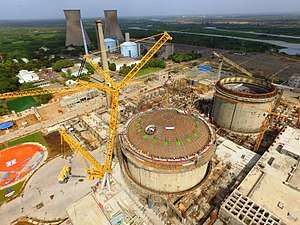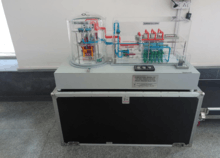IPHWR-700
The IPHWR-700 (Indian Pressurized Heavy Water Reactor-700) is an Indian pressurized heavy-water reactor designed by Bhabha Atomic Research Centre[1]. It is a Generation III+ reactor developed from earlier 220 MW and 540 MW designs and can generate 700 MW of electricity. Currently there are 6 units under construction and 10 more units planned at a cost of INR 1.05 trillion (US$ 14 billion)
| IPHWR-700 Reactor Class | |
|---|---|
 Kakrapar Atomic Power Station reactor units 3 and 4, under construction in the Indian state of Gujarat | |
| Generation | Generation III reactor |
| Reactor concept | pressurized heavy-water reactor |
| Reactor line | IPHWR |
| Status |
|
| Main parameters of the reactor core | |
| Fuel (fissile material) | 235U (NU/SEU/LEU) |
| Fuel state | Solid |
| Neutron energy spectrum | Thermal |
| Primary control method | control rods |
| Primary moderator | Heavy water |
| Primary coolant | Heavy water |
| Reactor usage | |
| Primary use | Generation of electricity |
| Power (thermal) | 2166 MWth |
| Power (electric) | 700 MWe |
Development
The PHWR technology was introduced in India in the late 1960s with the construction of RAPS-1 CANDU reactor in Rajasthan. All the main components for first unit were supplied by Canada while India did the construction, installation and commissioning job. In 1974 after India conducted Smiling Buddha, its first nuclear weapons test Canada stopped their support of the project, delaying the commissioning of RAPS-2 until 1981.[2]
After Canadian withdrawal from project, research, design and development work in Bhabha Atomic Research Centre and Nuclear Power Corporation of India (NPCIL) along with some industry partners who did the manufacturing and construction work enabled India in establishing this technology in totality. Over four decades, 15 220 MW reactors of indigenous design were built. Improvements were made in the original CANDU design to reduce construction time and cost, new safety systems were incorporated and thus reliability was enhanced leading to better capacity factors. Realising the economics of scale, a 540 MW design was developed by NPCIL. 2 units of this design were constructed at the Tarapur Atomic Power Station. Further optimisations were carried out to utilise the excess thermal margins and the 540 MW PHWR design was modified to that of 700 MW capacity without much design changes. Almost 100% of the components of these indigenously designed reactors are manufactured by the Indian industry.[3]
Design
Like other pressurized heavy-water reactors, IPHWR-700 uses heavy water (deuterium oxide D2O) as its coolant and neutron moderator. The design retains the features of standardized Indian PHWR units, which include:[4]

- Two diverse and fast acting shutdown systems
- Double containment of reactor building
- Water filled calandria vault
- Integral calandria - end shield assembly
- Zr-2.5% Nb pressure tubes separated from respective calandria tubes
- Calandria tube filled with carbon dioxide (which is recirculated) to monitor pressure tube leak
It also includes some new features as well. These include:
- Partial boiling at the coolant channel outlet
- Interleaving of primary heat transport system feeders
- Passive decay heat removal system
- Regional over power protection
- Containment spray system
- Mobile fuel transfer machine
- Steel lined containment wall
The reactor has very less excess reactivity because of which it does not need neutron poison inside the fuel or moderator. These provisions are made in design to handle the case of a loss of coolant accident which caused Fukushima Daiichi nuclear disaster.[5]
Operation
The reactor uses 0.7% enriched uranium with Zircaloy-4 cladding as fuel. The core produces 2166 MW of heat which is converted into 700 MW of electricity at an efficiency of 32%. Because of lack of excess reactivity inside the reactor, it needs to be refuelled continuously during operation. The reactor is designed for an estimated life of 60 years.[6]
Reactor fleet
| Power station | Operator | State | Units | Total capacity | Expected Commercial Operation[7] |
|---|---|---|---|---|---|
| Kakrapar Unit 3 and 4 | NPCIL | Gujarat | 700 x 2 | 1,400 | 2020 |
| Rajasthan Unit 7 and 8 | NPCIL | Rajasthan | 700 x 2 | 1,400 | 2022[8] |
| Gorakhpur Unit 1 and 2 | NPCIL | Haryana | 700 x 2 | 1,400 | 2025[8][9] |
| Power station | Operator | State | Units | Total capacity |
|---|---|---|---|---|
| Mahi Banswara | NPCIL | Rajasthan | 700 x 4 | 2,800 |
| Kaiga | NPCIL | Karnataka | 700 x 2 | 1,400 |
| Chutka | NPCIL | Madhya Pradesh | 700 x 2 | 1,400 |
| Gorakhpur | NPCIL | Haryana | 700 x 2 | 1,400 |
References
- "ANU SHAKTI: Atomic Energy In India". BARC.
- "Rajasthan Atomic Power Station (RAPS)". Nuclear Threat Initiative. 1 September 2003. Retrieved 18 February 2017.
- "Pressurised Heavy Water Reactor". PIB. Dr. S Banerjee.
- "Status report 105 - Indian 700 MWe PHWR (IPHWR-700)" (PDF). IAEA.
- "Advanced Large Water Cooled Reactors" (PDF). IAEA.
- "Advanced Large Water Cooled Reactors" (PDF). IAEA.
- "Bright prospects for India's future fleet". Nuclear Engineering International. Retrieved 2020-04-13.
- "Annual Report 2018-19 DAE" (PDF). Department of Atomic Energy. Retrieved 13 February 2020.
- "First phase Gorakhpur Haryana Atomic Power Plant expected to be completed in 2025". Business Standard. Retrieved 2 January 2019.
- "Setting up of Ten Indigenous Nuclear Power Reactors". Press Information Bureau. Retrieved 19 July 2018.